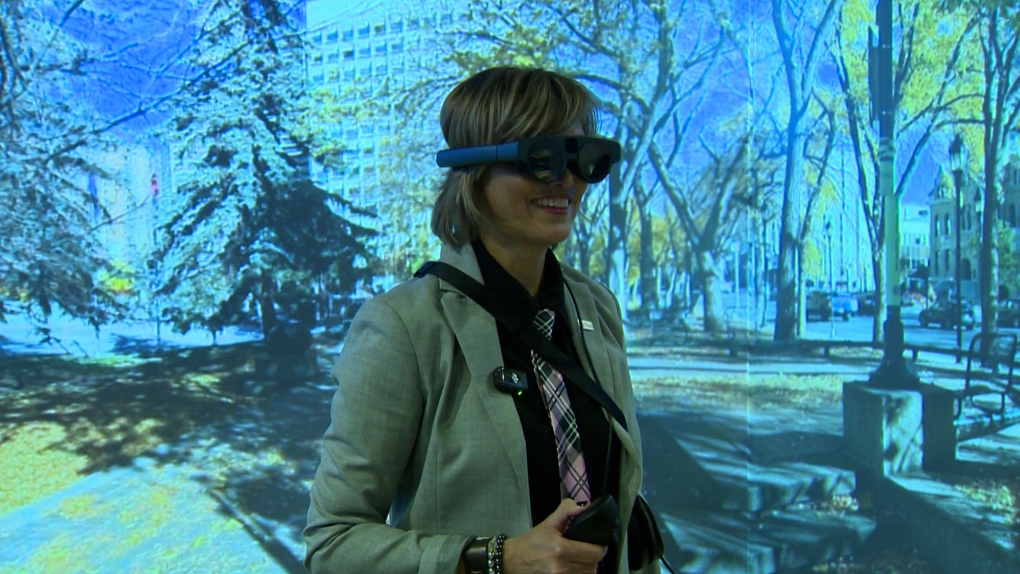Calgary launches Wave Tech Centre to boost innovation across city departments
From 3D-printed concrete park benches to using artificial intelligence to detect pavement problems before a pothole, the city has launched its Wave Tech Centre to explore how innovation could help find solutions across its departments.
The centre is officially open at the Andrew Davison building in downtown Calgary and has displays of robotic arms, 3D printers and an immersion room for augmented and virtual reality.
Displaying the technology, including innovations from local businesses, allows city staff to test out potential solutions to problems the city is facing.
"We don't know all of the companies that are coming up with great creative solutions that we could deploy as a city. And if an organization comes directly to the city, there is a procurement process as well that we have to go through," said Mayor Jyoti Gondek.
"What this space allows us to do is work with the innovators and figure out how their technology can actually help us improve our service," she said.
The federal government announced $3.1 million for the Wave Tech Centre last year.
A big benefit of having the different technologies accessible to the city is being able to directly supply specialized parts for projects -- from 3D printed screws, bolts and pieces to concrete benches and planters.
"So we'll be printing park benches and when you print a park bench in concrete, you're saving all the shipping, you're just using raw materials," said Jason Cameron with Smart Cities.
"Another experiment we have with the U of C will be for city employees walking through neighborhoods and seeing, oh, this store front or this patio isn't wheelchair accessible...can I scan it with my iPhone? Just using the Lidar on your on your cell phone to send it to the printer and print a ramp for it?," he said.
Augmented and virtual reality (AR/VR) could be used for planning future projects, or potentially in public feedback scenarios.
The city is already using AI to spot problems on the streets to detect areas on the pavement that is wearing down faster than others.
"AI that we have deployed on our fleet vehicles is detecting road conditions," said Gondek.
"We are much better able to tell when deterioration is starting, as opposed to only being able to see a pothole that needs to be fixed."
 Mayor Jyoti Gondek tests a VR headset on Oct. 21, 2024, one of the many tools available in the city's new Wave Tech Studio.
Mayor Jyoti Gondek tests a VR headset on Oct. 21, 2024, one of the many tools available in the city's new Wave Tech Studio.
The city is also exploring ways to expand its emergency alert system to display messages on cell phones and digital signage in areas that are impacted.
CTVNews.ca Top Stories

Bird flu, measles top 2025 concerns for Canada's chief public health officer
As we enter 2025, Dr. Theresa Tam has her eye on H5N1 bird flu, an emerging virus that had its first human case in Canada this year.
Azerbaijan observes day of mourning for air crash victims as speculation mount about its cause
Azerbaijan on Thursday observed a nationwide day of mourning for the victims of the plane crash that killed 38 people and left all 29 survivors injured as speculation mounted about a possible cause of the disaster that remained unknown.
Donald Trump says he urged Wayne Gretzky to run for prime minister in Christmas visit
U.S. president-elect Donald Trump says he told Canadian hockey legend Wayne Gretzky he should run for prime minister during a Christmas visit but adds that the athlete declined interest in politics.
6,000 inmates stage Christmas Day escape from high-security Mozambique prison
At least 6,000 inmates escaped from a high-security prison in Mozambique's capital on Christmas Day after a rebellion, the country's police chief said, as widespread post-election riots and violence continue to engulf the country.
Working Well: Returning to the office can disrupt life. Here are some tips to navigate the changes
Heading into 2025, thousands of workers face an unsettling reality: after years of working from the comfort of home, they must return to the office full-time for the first time since the coronavirus pandemic or look for new work.
New York taxi driver hits 6 pedestrians, 3 taken to hospital, police say
A taxicab hit six pedestrians in midtown Manhattan on Wednesday, police said, with three people — including a 9-year-old boy — transported to hospitals for their injuries.
Prayers and tears mark 20 years since the Indian Ocean tsunami that killed some 230,000 people
People gathered in prayer and visited mass graves in Indonesia’s Aceh province on Thursday to mark 20 years since the massive Indian Ocean tsunami hit the region in one of modern history’s worst natural disasters.
Historical mysteries solved by science in 2024
This year, scientists were able to pull back the curtain on mysteries surrounding figures across history, both known and unknown, to reveal more about their unique stories.
Thousands without power on Christmas as winds, rain continue in B.C. coastal areas
Thousands of people in British Columbia are without power on Christmas Day as ongoing rainfall and strong winds collapse power lines, disrupt travel and toss around holiday decorations.































